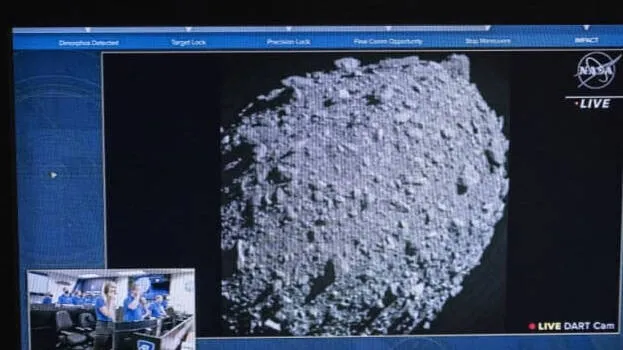

LOS ANGELES: Hurtling through the solar system at hypersonic speed on Monday, NASA's DART spacecraft slammed itself into a distant asteroid in a test of the world's first planetary defense system, designed to prevent a potential doomsday meteorite collision with Earth.
The finale to the suicide spaceflight, humanity's first attempt to alter the motion of an asteroid or any celestial body, played out in a NASA webcast from the mission operations center outside Washington, DC, 10 months after DART was launched.
The livestream showed images taken by DART's own camera as the cube-shaped "impactor" vehicle, no bigger than a vending machine with two rectangular solar arrays, streaked into the asteroid Dimorphos, about the size of a football stadium, at around 7 p.m. EDT (2300 GMT) some 6.8 million miles (11 million km) from Earth.Los Angeles: Hurtling through the solar system at hypersonic speed on Monday, NASA's DART spacecraft slammed itself into a distant asteroid in a test of the world's first planetary defense system, designed to prevent a potential doomsday meteorite collision with Earth.
Did you catch the #DARTMission stream live or Didymos it? Impact is over, but the research continues. As scientists delve into data and telescopes release images of the asteroid from their POV, follow @AsteroidWatch and @NASASolarSystem for updates. https://t.co/ZNEYDQVA8Y pic.twitter.com/dn2veS6zbG
— NASA (@NASA) September 27, 2022
The mission was devised to determine whether a spacecraft is capable of changing the trajectory of an asteroid through sheer kinetic force, nudging it off course just enough to keep our planet out of harm's way.
Whether it succeeded beyond accomplishing its intended impact will not be known until further ground-based telescope observations of the asteroid next month. But NASA officials hailed the immediate outcome of Monday's experiment, saying the spacecraft appeared to have performed as designed.
DART, launched by a SpaceX rocket in November 2021, made most of its voyage under the guidance of NASA's flight directors, with control handed over to an autonomous on-board navigation system in the final hours of the journey.
Monday evening's impact was monitored in near real time from the mission operations center at the Johns Hopkins University Applied Physics Laboratory (APL) in Laurel, Maryland.
Cheers could be heard from engineers in the control room as second-by-second images of the target asteroid grew larger and ultimately filled the TV screen of NASA's live webcast just before the spacecraft's signal was lost, confirming it had successfully crashed into Dimorphos.
